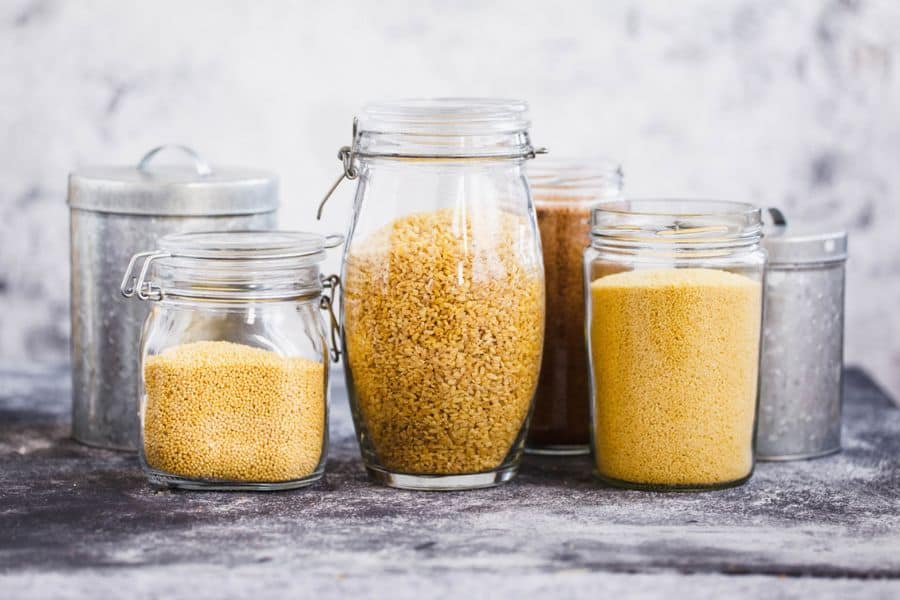11 Best Low Carb Grains: Nutrient-Dense And Healthy Choices

Definition | Types | Benefits | Tips | Keto Friendly Grains
Grains are the primary component of staple foods around the world. But if you are on a low carb diet like Keto Diet, Dukan Diet, or Paleo Diet, regular grains pose a huge nutritional challenge.
This is where low carb grains enter the picture.
Low carb grains are a healthier alternative to regular grains, as they typically contain fewer carbohydrates, making them suitable for those following a low-carb diet.
Explanation of Low Carb Grains
Low-carb grains contain fewer carbohydrates compared to regular grains. These grains fall in the low-carb category by virtue of being high in fiber and consequently low in net carbs.
Net carbs [1]American Diabetes Association: What are “Net Carbs?” refer to the amount of carbohydrates derived after subtracting the fiber from the total carbs in any food.
According to the dietary guidelines of USDA [2]U.S. Department of Health and Human Services: DIETARY GUIDELINES FOR AMERICANS 2015-2020 EIGHTH EDITION, an average, healthy individual’s diet should be comprised of 45-65% carbohydrates. This comes to 900 -1300 calories (200-350 grams) if you consume approximately 2000 calories per day.
In low-carb diets, the percentage of carbs is much lower. Here is a list that can give a clearer picture of carbohydrate requirements in low carb diets [3]National Library of Medicine: Low Carbohydrate Diet:
- Very low-carbohydrate diets (less than 10% carbohydrates) or 20 to 50 gm/day
- Low-carbohydrate diets (less than 26% carbohydrates) or less than 130 gm/day
- Moderate-carbohydrate (26% to 44%)
Types of Low Carb Grains
Below is a list of the healthiest low carb grains. The nutritional information provided below has been taken from the pages of USDA’s Food Data Central [4]U.S. DEPARTMENT OF AGRICULTURE: FoodData Central Search Results.
1. Couscous
Couscous is a small pasta-like grain made from durum wheat, but it is also available in whole wheat or whole grain options. 1/2 cup of cooked couscous has as little as 18 gms of carbs, making it a lower carb option compared to other grains.
It contains selenium, which is beneficial for cognitive health [5]National Library of Medicine: Selenium Deficiency, metabolism, cardiovascular health and immunity.
2. Quinoa
Quinoa is a gluten-free, anti-oxidant-rich, low-carb grain that contains approximately 54 grams of carbohydrates for every ½ cup serving. It is also a complete protein, meaning it contains all nine essential amino acids.
It is gluten-free and packed with micronutrients like folate, zinc and magnesium. It is an excellent option for vegetarians and vegans looking for nutrient-dense, low-carb grains.
3. Millet
Millet is a gluten-free grain that is rich in fiber and antioxidants. It contains approximately 70 grams of carbohydrates per 1/2 cup serving and has a slightly sweet and nutty flavor. It also provides essential vitamins and minerals like folate, calcium, and magnesium.
4. Oats
Oats are a popular grain that can be used in various dishes, such as oatmeal, granola, and baked goods. Half cup of raw oats contains just 54 grams of carbohydrates. They are also high in fiber and protein, making them a healthy option.
Moreover, oats also contain a generous amount of micronutrients, including calcium, magnesium, iron, selenium, niacin, and thiamin.
5. Buckwheat
Despite its name, buckwheat is not a type of wheat and is, therefore, gluten-free. Apart from being safe for people with celiac disease and for those on a strict gluten free diet, it is also a complete protein (contains all 9 amino acids). Additionally, it contains a rich dose of fiber, minerals like magnesium, and B vitamins.
Buckwheat contains approximately 60 grams of carbohydrates for every 1/2 cup serving. Buckwheat is commonly used in dishes such as soba noodles and pancakes.
6. Rye
Rye is a type of grain that is commonly used in bread and has a distinctive earthy flavor. It contains around 15 grams of carbohydrates per 1/2 cup serving and is a good source of fiber and vitamins.
7. Wild Rice
Wild rice is a nutrient-dense grain that is high in fiber, protein, and antioxidants. Half a cup of cooked wild rice contains approximately 17 grams of carbohydrates. It has a chewy texture and nutty flavor.
8. Barley
Barley is a versatile grain that is commonly used in soups, stews, and salads. It contains around 65- 67 grams of carbohydrates per 1/2 cup and is a good source of fiber and vitamins.
9. Spelt
Spelt is an ancient grain that is related to wheat but has a nuttier flavor and is lower in gluten. It contains approximately 60 grams of carbohydrates for every 1/2 cup and is a good source of fiber and protein.
10. Bulgur
Bulgur is made by milling cracked wheat berries. It is commonly used in Middle Eastern and Mediterranean cuisines. Rich in fiber and protein, ½ cup of raw bulgur contains around 53 grams of carbohydrates. Bulgur is commonly used in dishes such as tabbouleh and pilaf.
11. Teff
Teff is a tiny grain that is native to Ethiopia and is rich in fiber, protein, and minerals. It contains approximately 70 grams of carbohydrates per 1/2 cup serving and has a slightly sweet and nutty flavor. Teff is commonly used to make injera, a traditional Ethiopian flatbread.
Carb content table for low carb grains
Here is a table listing out the carbohydrate content of the grains listed above:
| Grain | Carbohydrate Content (per 1/2 cup serving) |
| Couscous | 18g |
| Quinoa | 54g |
| Millet | 70g |
| Oats | 54g |
| Buckwheat | 60g |
| Rye | 15g |
| Wild Rice | 17g |
| Barley | 65-67g |
| Spelt | 60g |
| Bulgur | 53g |
| Teff | 70g |
Benefits of Low Carb Grains
Incorporating low carb grains into your diet can offer several health benefits:
- High in fiber: Low carb grains are typically high in fiber, which can help improve digestion, promote satiety, and regulate blood sugar levels. Fiber also plays a crucial role in heart health by helping to lower cholesterol levels.
- Good source of protein: Many low carb grains, such as quinoa, buckwheat, and teff, are excellent sources of plant-based protein. Protein is essential for building and repairing tissues, supporting the immune system, and promoting healthy hair, skin, and nails.
- Low glycemic index: Low carb grains generally have a lower glycemic index compared to high-carb grains. The glycemic index measures how quickly a food raises blood sugar levels. Low glycemic index foods can help regulate blood sugar levels and provide sustained energy, making them ideal for individuals with diabetes or those looking to manage their blood sugar levels.
- Nutrient-dense: Low carb grains are often packed with essential nutrients such as vitamins, minerals, and antioxidants. These nutrients are vital for overall health and well-being, including supporting immune function, promoting bone health, and reducing the risk of chronic diseases.
Tips for Incorporating Low-Carb Grains into Your Diet
Here are some tips to help you incorporate healthy grains like the ones listed above into your diet:
- Replace high-carb grains with low-carb options: Instead of using regular refined grains like rice or wheat, swap them with low carb grains such as cooked millet, quinoa, or wild rice or even other healthy grains like brown rice in your meals. You can use these low carb whole grains in salads, stir-fries, stews, or as a side dish.
- Add grains to salads: Adding cooked low carb grains like quinoa, couscous, or bulgur to your salads can add texture, flavor, and nutrition. They can make your salads more filling and satisfying, and provide a good balance of carbohydrates, protein, and fiber.
- Make low carb grain bowls: Create delicious and nutritious grain bowls by combining cooked low carb grains with a variety of vegetables, proteins, and healthy fats. You can customize your grain bowls to suit your taste preferences and dietary needs, making them a versatile and convenient meal option.
What Grains are Keto-Friendly?
The Ketogenic Diet, also known as the Keto Diet, is a low-carb, high-fat diet that aims to put the body into a state of ketosis [6]Cleveland Clinic: Ketosis, where it burns fat for energy instead of carbohydrates. Therefore, grains that are low in carbohydrates are generally considered more suitable for a keto diet. Some grains that are considered keto-friendly due to their low carb content include:
- Quinoa: With approximately 54 grams of carbohydrates per 1/2 cup serving, quinoa is relatively low in carbs compared to other grains. It is also high in protein and fiber, making it a good option for those following a keto diet.
- Buckwheat: Buckwheat is another grain that is low in carbs, with around 60 grams of carbohydrates per 1/2 cup serving. It is also a good source of protein and fiber, making it a nutritious choice for a keto diet.
- Rye: Rye is a grain that is lower in carbohydrates compared to some other grains, with approximately 15 grams of carbohydrates per 1/2 cup serving. It is also a good source of fiber, which can help with digestion and satiety.
- Wild Rice: Wild rice is a low carb grain with approximately 17 grams of carbohydrates per 1/2 cup serving. It is also high in fiber and protein, making it a good option for those following a keto diet.
- Spelt: Spelt is a type of wheat that is lower in carbohydrates compared to regular wheat, with around 60 grams of carbohydrates per 1/2 cup serving. It is also high in fiber and protein, making it a good alternative for those on a keto diet.
It’s important to note that the amount of grains allowed on a keto diet may vary depending on individual macronutrient requirements and personal preferences.
It’s always best to consult with a healthcare professional or a registered dietitian before making any significant changes to your diet, especially if you have any health conditions or dietary restrictions.
Conclusion
Incorporating low carb grains into your diet can be a healthy and nutritious option. However, it’s essential to consider your individual dietary requirements and preference before making any significant changes to your diet. With the right knowledge and planning, low carb grains can be a delicious and nutritious addition to a healthy and balanced diet.
References
| ↑1 | American Diabetes Association: What are “Net Carbs?” |
|---|---|
| ↑2 | U.S. Department of Health and Human Services: DIETARY GUIDELINES FOR AMERICANS 2015-2020 EIGHTH EDITION |
| ↑3 | National Library of Medicine: Low Carbohydrate Diet |
| ↑4 | U.S. DEPARTMENT OF AGRICULTURE: FoodData Central Search Results |
| ↑5 | National Library of Medicine: Selenium Deficiency |
| ↑6 | Cleveland Clinic: Ketosis |







